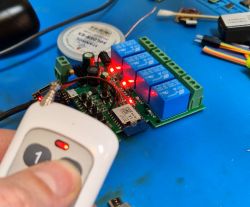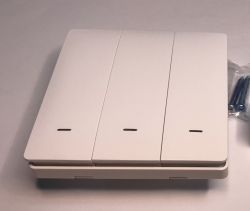FAQ
TL;DR: The LVJING Wi-Fi grow light drives 220 LEDs through a 12-channel UCS1912S at 255-step PWM resolution [Elektroda, Sergio127, post #20272214] “Magic Home devices do not work with eWeLink” [Elektroda, p.kaczmarek2, post #20265831]
Why it matters: Knowing the hardware and firmware limits avoids wasted integration effort and prevents accidental bricking.
Quick Facts
• MCU: Bouffalolab BL602, 32-bit RISC-V @ 32 MHz, 2.4 GHz Wi-Fi [Bouffalab DS].
• Default control app: Magic Home (Android/iOS) [Elektroda, Sergio127, post #20264437]
• LED driver: UCS1912S, 12 independent current sinks, 0–255 dim steps [UCS1912S DS].
• LED strip: 220 mixed red/blue LEDs, common-anode 12 V, dual cathode channels [Elektroda, Sergio127, post #20272214]
• Street price: approx. US$18 on AliExpress (Oct 2022 listing).
What controller powers the LVJING Wi-Fi Plant Grow Light?
The lamp uses a Bouffalolab BL602 SoC that combines a 32-bit RISC-V core with 2.4 GHz Wi-Fi and GPIOs for buttons and data output [Elektroda, Sergio127, post #20264437]
Which BL602 GPIO pins map to the front-panel buttons?
GPIO3 = Reverse, GPIO4 = Down, GPIO17 = Clock, GPIO20 = Up, GPIO21 = Power [Elektroda, Sergio127, post #20264437]
Does the lamp work with the eWeLink or Tuya apps?
No. “Magic Home devices do not work with eWeLink App. They are not even Tuya” [Elektroda, p.kaczmarek2, post #20265831]
Why does Home Assistant only show an On/Off switch?
Magic Home’s current Home Assistant integration exposes only the power toggle, so brightness and spectrum sliders stay hidden [Elektroda, Sergio127, post #20265836]
How is the internal LED strip wired?
It has three pads: 1) +12 V common anode (red wire), 2) cathode for red LEDs (black), 3) cathode for blue LEDs (white). No data line is present [Elektroda, Sergio127, post #20272214]
What does the UCS1912S chip actually do?
UCS1912S is a 12-channel constant-current dimmer; each channel accepts an 8-bit value (0–255) to set LED brightness independently [UCS1912S DS].
How many LEDs and what power does the strip draw?
There are 220 LEDs (55 × 4 segments). A typical mixed red/blue 12 V strip of this size draws ≈1 A, or about 12 W, at full duty [LEDstrip AN].
Can I already flash community firmware and control every channel?
Developer build 1.14.133 only contains a stub UCS1912S driver; channels do not respond yet [Elektroda, p.kaczmarek2, post #20271117]
Why does the firmware version stay 1.14.133 after flashing?
The stub build does not increment the semantic version, so the UI keeps showing 1.14.133—a harmless but confusing edge-case [Elektroda, Sergio127, post #20272214]
Is there a risk of damaging the lamp while testing?
Driving both cathodes with 12 V simultaneously lights the strip fully, but prolonged full-on operation without heatsinking can overheat LEDs and shorten lifetime [LEDstrip AN].
How do I flash alternative firmware over serial?
- Solder RX (GPIO7), TX (GPIO16), 3.3 V, and GND to a USB-TTL adapter.
- Hold the Reverse button (GPIO3) to enter boot mode, then power the board.
- Use blflash to upload the .bin at 2 Mbps. Release the button and reset.
Follow-up console commands will verify channel output [Elektroda, Sergio127, post #20271098]
How will testers know once full UCS1912S support lands?
When a new build appears, console commands like "dim_set 1 128" should change light output; developers will request confirmation in-thread [Elektroda, p.kaczmarek2, post #20271117]
![[BL602] LVJING WIFI LED Plant Grow Light [BL602] LVJING WIFI LED Plant Grow Light](https://obrazki.elektroda.pl/3800183000_1667396617_thumb.jpg)
![[BL602] LVJING WIFI LED Plant Grow Light [BL602] LVJING WIFI LED Plant Grow Light](https://obrazki.elektroda.pl/3803836400_1667396619_thumb.jpg)
![[BL602] LVJING WIFI LED Plant Grow Light [BL602] LVJING WIFI LED Plant Grow Light](https://obrazki.elektroda.pl/8487114300_1667396623_thumb.jpg)
![[BL602] LVJING WIFI LED Plant Grow Light [BL602] LVJING WIFI LED Plant Grow Light](https://obrazki.elektroda.pl/3915467700_1667396627_thumb.jpg)
![[BL602] LVJING WIFI LED Plant Grow Light [BL602] LVJING WIFI LED Plant Grow Light](https://obrazki.elektroda.pl/3769424000_1667396629_thumb.jpg)
![[BL602] LVJING WIFI LED Plant Grow Light [BL602] LVJING WIFI LED Plant Grow Light](https://obrazki.elektroda.pl/3423082100_1667396634_thumb.jpg)
![[BL602] LVJING WIFI LED Plant Grow Light [BL602] LVJING WIFI LED Plant Grow Light](https://obrazki.elektroda.pl/5172237600_1667396641_thumb.jpg)
![[BL602] LVJING WIFI LED Plant Grow Light [BL602] LVJING WIFI LED Plant Grow Light](https://obrazki.elektroda.pl/2313322100_1667396653_thumb.jpg)
![[BL602] LVJING WIFI LED Plant Grow Light [BL602] LVJING WIFI LED Plant Grow Light](https://obrazki.elektroda.pl/9215846700_1667396719_thumb.jpg)
![[BL602] LVJING WIFI LED Plant Grow Light [BL602] LVJING WIFI LED Plant Grow Light](https://obrazki.elektroda.pl/7902607300_1667396733_thumb.jpg)
![[BL602] LVJING WIFI LED Plant Grow Light [BL602] LVJING WIFI LED Plant Grow Light](https://obrazki.elektroda.pl/8303564000_1667396816_thumb.jpg)
![[BL602] LVJING WIFI LED Plant Grow Light [BL602] LVJING WIFI LED Plant Grow Light](https://obrazki.elektroda.pl/3800183000_1667396617_thumb.jpg)
![[BL602] LVJING WIFI LED Plant Grow Light [BL602] LVJING WIFI LED Plant Grow Light](https://obrazki.elektroda.pl/3803836400_1667396619_thumb.jpg)
![[BL602] LVJING WIFI LED Plant Grow Light [BL602] LVJING WIFI LED Plant Grow Light](https://obrazki.elektroda.pl/8487114300_1667396623_thumb.jpg)
![[BL602] LVJING WIFI LED Plant Grow Light [BL602] LVJING WIFI LED Plant Grow Light](https://obrazki.elektroda.pl/3915467700_1667396627_thumb.jpg)
![[BL602] LVJING WIFI LED Plant Grow Light [BL602] LVJING WIFI LED Plant Grow Light](https://obrazki.elektroda.pl/3769424000_1667396629_thumb.jpg)
![[BL602] LVJING WIFI LED Plant Grow Light [BL602] LVJING WIFI LED Plant Grow Light](https://obrazki.elektroda.pl/3423082100_1667396634_thumb.jpg)
![[BL602] LVJING WIFI LED Plant Grow Light [BL602] LVJING WIFI LED Plant Grow Light](https://obrazki.elektroda.pl/5172237600_1667396641_thumb.jpg)
![[BL602] LVJING WIFI LED Plant Grow Light [BL602] LVJING WIFI LED Plant Grow Light](https://obrazki.elektroda.pl/2313322100_1667396653_thumb.jpg)
![[BL602] LVJING WIFI LED Plant Grow Light [BL602] LVJING WIFI LED Plant Grow Light](https://obrazki.elektroda.pl/9215846700_1667396719_thumb.jpg)
![[BL602] LVJING WIFI LED Plant Grow Light [BL602] LVJING WIFI LED Plant Grow Light](https://obrazki.elektroda.pl/7902607300_1667396733_thumb.jpg)
![[BL602] LVJING WIFI LED Plant Grow Light [BL602] LVJING WIFI LED Plant Grow Light](https://obrazki.elektroda.pl/8303564000_1667396816_thumb.jpg)








![[BL602] LVJING WIFI LED Plant Grow Light [BL602] LVJING WIFI LED Plant Grow Light](https://obrazki.elektroda.pl/9825359400_1667466913_thumb.jpg)
![[BL602] LVJING WIFI LED Plant Grow Light [BL602] LVJING WIFI LED Plant Grow Light](https://obrazki.elektroda.pl/7772271500_1667468454_thumb.jpg)
![[BL602] LVJING WIFI LED Plant Grow Light [BL602] LVJING WIFI LED Plant Grow Light](https://obrazki.elektroda.pl/5659954700_1667468620_thumb.jpg)
![[BL602] LVJING WIFI LED Plant Grow Light [BL602] LVJING WIFI LED Plant Grow Light](https://obrazki.elektroda.pl/1150397000_1667468638_thumb.jpg)
![[BL602] LVJING WIFI LED Plant Grow Light [BL602] LVJING WIFI LED Plant Grow Light](https://obrazki.elektroda.pl/1730643200_1667468763_thumb.jpg)
![[BL602] LVJING WIFI LED Plant Grow Light [BL602] LVJING WIFI LED Plant Grow Light](https://obrazki.elektroda.pl/2056730900_1667809107_thumb.jpg)